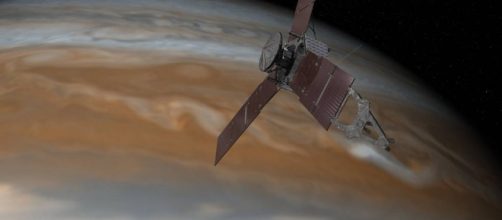July 4, if all goes well, will be an occasion for celebration at NASA as the Juno spacecraft, after a nearly five-year voyage, will go into orbit around Jupiter, the largest planet in the solar system. Juno will spend its time in a zone of intense radiation, against which it has been armored, in an effort to ferret out Jupiter’s secrets. By so doing, NASA hopes to gain insights into the origin of the solar system as well as gaining more knowledge of the gas giant, comprised mostly of hydrogen and helium with trace elements of carbon, nitrogen, and sulfur.
Previously, the Galileo spacecraft orbited Jupiter in a wider orbit, studying the planet and its moons. Before that, two Voyager spacecraft flew by the Jovian system on their way to exploring the other gas giants, Saturn, Uranus, and Neptune.
Among the questions scientists would like to answer are:
Does Jupiter have oxygen and water in its atmosphere? Galileo found very little if any of either when it plunged into the planet at the end of its mission.
Does Jupiter have a solid core as most scientists postulate? If so does it comprise nickel and iron or is it compressed, solid hydrogen?
What, exactly, is the famous red spot? It is an atmospheric disturbance, as most scientists believe, or is it something else?
Juno’s solar power system will provide only 500 watts of power to a suite of instruments, including an infrared spectrometer, an ultraviolet spectrograph, a visible-light camera, a magnetometer and a plasma wave sensor. A microwave sensor will analyze Jupiter’s atmosphere, and another sensor will ferret out the planet’s core.
Juno’s primary science mission will last 20 months. NASA is unlikely to extend that mission because the intense radiation where Juno will be operating will likely take its toll.
As of this writing, Juno has entered Jupiter’s magnetosphere which blocks the planet from solar radiation. NASA is due to send a command to the spacecraft to initiate its autopilot. That means, if all goes well, Juno will fire its engines that will place it into orbit around Jupiter on the 4th of July.

